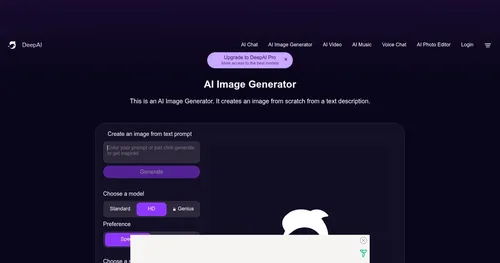VideoWeb AI

VideoWeb AI is an online platform that generates videos, images, and music using AI models such as Kling AI, Runway, Luma AI, and Hailuo AI. It processes inputs like text prompts or uploaded images to produce outputs in formats including MP4 and GIF, with resolutions up to 1080p. The tool supports features for transforming static content into dynamic sequences and includes options for commercial use on paid plans.
Core functionalities cover image-to-video conversion, where users upload a photo and apply effects like AI Dance for animated movements or AI Hug for interaction simulations. Text-to-video allows script-based generation, with customizable styles and durations up to several minutes. Image generation uses Flux.1 models for detailed visuals, and music creation draws from voice or prompt inputs to produce tracks that sync with videos. Processing occurs via a queue system, with paid tiers offering priority access and unlimited daily uses of basic tools.
Competitors include Runway, which provides advanced motion editing but requires more setup for integrations, and Luma AI, focused on extension tools for longer clips though with higher latency on free access. Synthesia specializes in avatar-based videos, differing from VideoWeb’s broader model variety, while Pika Labs offers unlimited generations on entry plans but lacks bundled music features. VideoWeb’s structure uses credits for generations, with free access at 40 initial plus 20 daily, scaling to 35,000 monthly on top tiers, generally more accessible than Runway’s model but comparable to Luma’s.
Users report fast generation times, often under a minute for shorts, and strong privacy controls with no data retention on uploads. Outputs lack watermarks on paid plans, supporting direct exports for social platforms. Limitations involve occasional inconsistencies in complex motions, such as clipping in dance sequences, and credit limits restricting volume on free use.
The platform integrates multiple models into one interface, reducing need for separate tools, and provides 365-day history on paid accounts. It handles diverse inputs without software installs, running browser-based on devices from mobile to desktop.
Test features sequentially, beginning with simple prompts to calibrate expectations, then advance to multi-effect combinations for refined results.
Video Overview ▶️
What are the key features? ⭐
- AI Video Generation: Converts text prompts or images into videos using integrated models like Kling and Runway for realistic motion and effects.
- Image-to-Video: Animates static photos into dynamic clips with tools such as AI Dance for customizable movements and styles.
- Text-to-Video: Produces videos from descriptive scripts, supporting durations up to minutes with style adjustments and audio sync.
- AI Music Generation: Creates original tracks from voice inputs or prompts that automatically align with generated video content.
- Flux.1 Integration: Generates high-quality images from text for use as bases in video workflows or standalone visuals.
Who is it for? 🤔
Examples of what you can use it for 💭
- Social Media Influencer: Uses image-to-video to animate personal photos into engaging dance reels for TikTok, boosting follower interaction with minimal effort.
- E-commerce Marketer: Applies AI Dance effects to product images, creating short demo videos that highlight features dynamically for online ads.
- YouTube Creator: Leverages text-to-video for scripting educational clips, adding synced music to explain concepts in under five minutes.
- Small Business Owner: Generates custom promo videos from text descriptions, incorporating AI Hug for relatable brand storytelling on Instagram.
- Graphic Designer: Combines Flux.1 images with video tools to prototype animated logos, exporting ready files for client presentations.
Pros & Cons ⚖️
- Multi-model access
- Free tier available
- No watermarks paid
- Credit limits free
- Prompt inconsistencies
FAQs 💬
Related tools ↙️
-
 DeepSwapper
Face-swapping tool that allows users to swap faces in images, videos, and GIFs
DeepSwapper
Face-swapping tool that allows users to swap faces in images, videos, and GIFs
-
RoboNeo Generates images, edits photos, and creates videos via natural language prompts
-
 neural.love
An AI image generator and enhancer
neural.love
An AI image generator and enhancer
-
 AIEASE
An AI-powered platform offering a suite of free photo editing tools
AIEASE
An AI-powered platform offering a suite of free photo editing tools
-
WaveSpeedAI Accelerating AI image and video generation, delivering high-quality visuals at lightning fast speed.
-
 AI Image Generator
An AI-powered platform that generates images from text descriptions in various styles and resolutions.
AI Image Generator
An AI-powered platform that generates images from text descriptions in various styles and resolutions.

